by Lisa Cooke | Feb 12, 2018 | 01 What's New, German |
For a long time, German census records were thought not to exist. But they do! A leading German genealogy expert tells us how they’ve been discovered and catalogued—and where you can learn about German census records that may mention your family.
Thanks to James M. Beidler for contributing this guest article. Read more below about him and the free classes he’ll be teaching in the Genealogy Gems booth at RootsTech 2018 in a few short weeks.
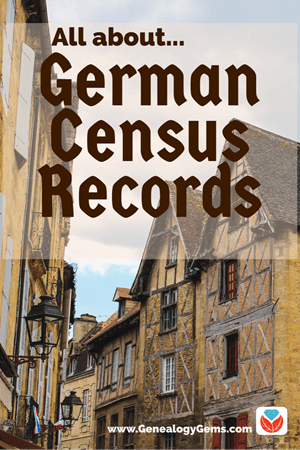
German census records DO exist
One of the truisms of researching ancestors in America is that the U.S. Census is a set of records that virtually every genealogist needs to use.
From its once-a-decade regularity to its easy accessibility, and the high percentage of survival to the present day, the U.S. Census helps researchers put together family groups across the centuries.
On the other hand, the thing that’s most distinctive about German census records is that for many years they were thought not to even exist.
For Exhibit A, look at this quote from a book published just a few years ago: “Most of the censuses that were taken have survived in purely statistical form, often with little information about individuals. There are relatively few censuses that are useful to genealogists.”
The book from which the above statement was taken is The Family Tree German Genealogy Guide. And the author of that book is … uh, well … me!
In my defense, this had been said by many specialists in German genealogy. The roots of this statement came from the honest assessment that Germany, which was a constellation of small states until the late 1700s and not a unified nation until 1871 when the Second German Empire was inaugurated, had few truly national records as a result of this history of disunity.
As with many situations in genealogy, we all can be victims of our own assumptions. The assumption here was that because it sounded right that Germany’s fractured, nonlinear history had produced so few other national records, those census records didn’t exist.
A few census records from northern German states (see below) had been microfilmed by the Family History Library, but for all intents and purposes, a greater understanding of the “lost” German census records had to wait for a project spearheaded by Roger P. Minert, the Brigham Young University professor who is one of the German genealogy world’s true scholars.
Finding lost and scattered German census records
It can be said that Brigham Young University professor Roger Minert “wrote the book” on the German census. That’s because he literally did: German Census Records, 1816-1916: The When, Where, and How of a Valuable Genealogical Resource. A sample page is shown below.
Minert had a team help him get the project rolling by writing to archivists in Germany before he took a six-month sabbatical in Europe. During this time, he scoured repositories for samples of their German census holdings (To some extent, Minert’s project had echoes of an earlier work led by Raymond S. Wright III that produced Ancestors in German Archives: A Guide to Family History Sources).
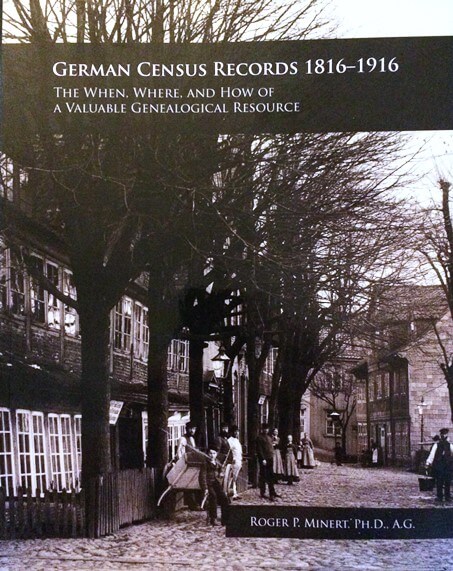
What resulted from Minert’s project was the census book and a wealth of previously unknown information about German censuses.
While a few censuses date to the 18th century in the German states (some are called Burgerbücher, German for “citizen books”), Minert found that the initiation of customs unions during the German Confederation period beginning after Napoleon in 1815 was when many areas of Germany began censuses.
The customs unions (the German word is Zollverein) needed a fair way to distribute income and expenses among member states, and population was that way. But to distribute by population, a census was needed to keep count, and most every German state began to take a census by 1834.
Until 1867, the type of information collected from one German state to another varied considerably. Many named just the head of the household, while others provided everyone’s names. Some include information about religion, occupation and homeownership.
The year 1867 was a teeter-totter point Minert calls it “for all practical purposes the first national census.” Prussia—by then the dominant German state and whose king would become the emperor just a few years hence—spearheaded the census effort.
After the founding of the Second German Empire, a census was taken every five years (1875 – 1916, the last census being delayed by World War I). While there was some variance in data from one census to another, they all included the following data points:
- names of each individual,
- gender,
- birth (year and, later, specific dates),
- marital status,
- religion,
- occupation,
- citizenship,
- and permanent place of residence (if different from where they were found in the census).
While some of these censuses are found in regional archives within today’s German states, in many cases the census rolls were kept locally and only statistics were forwarded to more central locations.
Interestingly, there has been a lack of awareness even among German archivists that their repositories have these types of records! Minert says in his book that in three incidences, archivists told him their holdings included no census records, only to be proved wrong in short order.
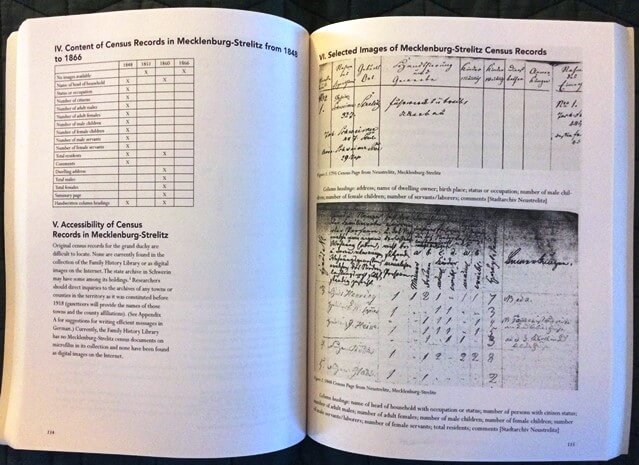
Minert’s book goes through the old German Empire state by state and analyzes where researchers are likely to find censuses. For each state, there is also a chart on the pre-Empire censuses and what information they included.
Researchers wishing to access these records will often need to contact local archives. If you’ve uncovered a village of origin for an immigrant, you could contact them directly by searching for a website for the town, then emailing to ask (politely but firmly) whether the archives has census records.
FamilySearch has placed online German census records for Mecklenburg-Schwerin (1867, 1890 and 1900; the one shown below is from 1867).
The Danish National Archives has some census records online for Schleswig-Holstein (much of the area was Danish until they lost a war with Prussia in 1864).
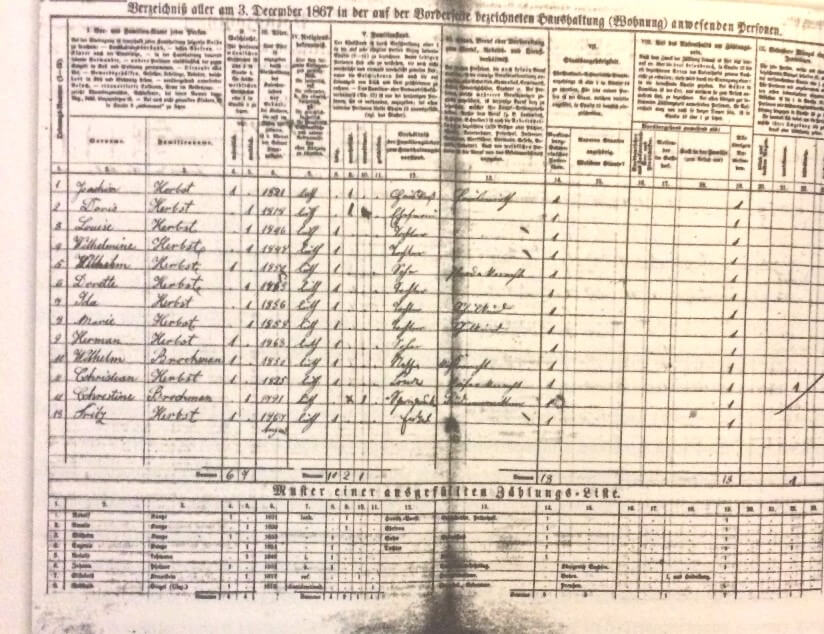
Other Census-Like Lists
In addition to these censuses, many areas of Germany have survivals of tax lists that serve as a record substitute with some data points that are similar to censuses. The lists generally show the name of the taxpayer and the amount of tax paid.
In some cases, versions of the lists that include the basis for the tax (usually the value of an interest in real or personal property) have survived. The lists may also include notes about emigration. Here’s a sample tax record from Steinwenden Pfalz.
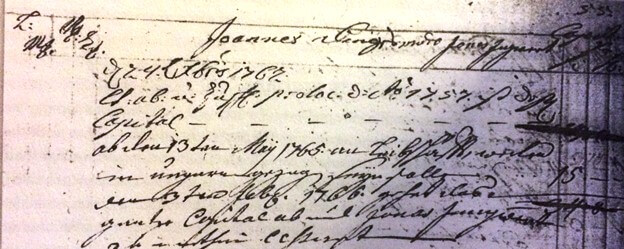
Some of these tax lists are available in the Family History Library system.
The best “clearinghouse” that reports the holdings of various repositories in Germany is Wright’s Ancestors in German Archives. As with the census records, the best way to contact local archives directly would be to search for a website for the town. E-mail to ask whether such lists are kept in a local archive.
In my personal research, tax records have proved crucial. For example, they confirmed the emigration of my ancestor Johannes Dinius in the Palatine town of Steinwenden. These records showed the family had left the area a few months before Dinius’ 1765 arrival in America.
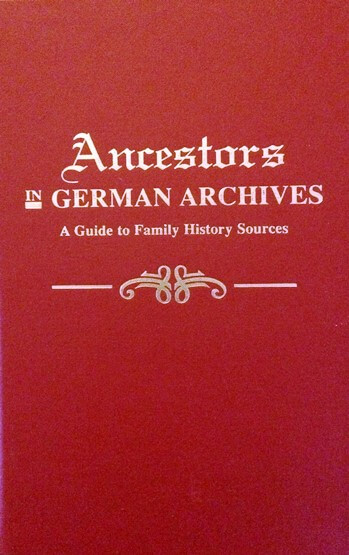

James M Beidler is the author of The Family Tree German Genealogy Guide and Trace Your German Roots Online.
Disclosure: This article contains affiliate links and Genealogy Gems will be compensated if you make a purchase after clicking on these links (at no additional cost to you). Thank you for supporting Genealogy Gems
by Lisa Cooke | Mar 24, 2017 | 01 What's New, German, Records & databases
Are you researching German genealogy in the States? If so, you will love what we’ve dug up. German death lists are just the start. Also in this week’s new and updated genealogical record collections, Irish Quaker records, UK pensioners records, and a new product support announcement for Family Tree Maker software.
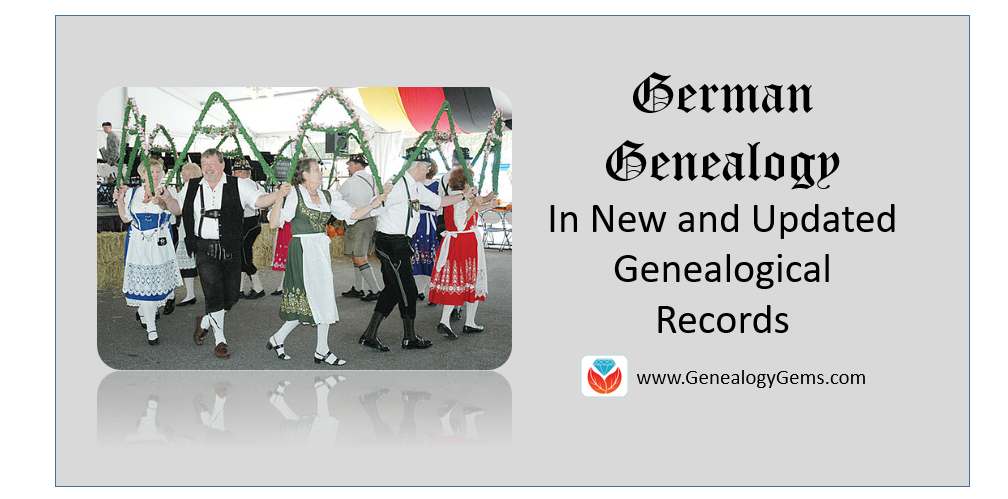
By Photos by Donna Hyatt (United States Army) [Public domain], via Wikimedia Commons.
German Genealogy in the States – Kentucky
You may not realize there was a large German population in Louisville, Kentucky, here in the United States. Our Book Club Guru, Sunny Morton, brought a new found website to our attention called German Genealogy Group. Among many other things, the German Genealogy Group has recently added newspaper death listings from the Louisville Anzeiger, a German newspaper from the Louisville, Kentucky area, to their website. The years covered are 1849-1865. Though only an index, the information provided will help you locate the newspaper itself.
Ireland – Quaker Birth Records
With over 302,000 new birth records from all over Ireland, you may finally find your Irish Quaker ancestors birth information. Ireland, Society of Friends (Quaker) births collection may help you uncover generations of your family tree. The amount of information listed on a birth record in this collection will vary, but most will include the child’s name, birth date, birth place, parish, and address. Most will also contain the parents’ names, addresses, and occupations.
Ireland – Quaker Marriage Records
Also at Findmypast, a collection titled Ireland, Society of Friends (Quaker) marriages has been updated. In fact, there have been over 20,000 new additions. These records will likely include data such as an occupation, parents’ names, and who attended the ceremony. As well as the names, address and marriage details of the newlyweds, parents’ names, an attendee list including names and dates of birth, and even details of the meeting may be found.
Ireland – Quaker Death & Congregational Records

By Holmes after Honthorst in 1654 [Public domain], via Wikimedia Commons. George Fox, Quaker founder.
Findmypast collection, Ireland, Society of Friends (Quaker) congregational records offers a wealth of knowledge about the role your ancestor might have played within the Quaker community. An additional 250,000 Irish congregational records have been added. Details of meetings and activities are just a sampling of what you will find. These records include a transcript as well as an image of the original handwritten record.
Ireland – Quaker School Records
Over 9,000 new records have been added to the Findmypast collection titled Ireland, Society of Friends (Quaker) school records. This collection covers six different schools and dates back as far as the 1700s. The records are compiled from various Quaker school registers and lists. Each entry includes both a transcript and an image of the original document. Details contained in each record will vary, but most will list the pupils name, age at last birthday, school and department, admission year, leaving year, parents’ names, and their occupations.
British Newspaper Archive Announcement
The British Newspaper Archive has recently announced a major new milestone in their project to digitize up to 40 million newspaper pages from the British Library’s vast collection of historic British & Irish newspapers. Following the addition of a newspaper for the country’s smallest county, Rutland, the Archive now covers at least one title from each of the country’s 48 counties and is now available to search and explore.
As part of this push to improve the British Newspaper Archive experience, a new “In Pictures” feature has also been added.
The British Newspaper Archive now contains over 18.7 million pages from 747 titles from England, Wales, Scotland, and Ireland and spans nearly 300 (1709-2003) years.
United Kingdom – Chelsea – Pensioner Service Records
Fold3.com has a collection titled UK, Royal Hospital Chelsea Pensioner Soldier Service Records. This collection includes those who would have been eligible to receive a pension from the British Army between 1760-1920.

The collection contains records for British soldiers (not officers) who received a pension from the British Army. They typically do not include records for soldiers who died in service or who were discharged early and did not receive a pension.
Some records contain more information than others, and pension documents after 1883 typically have more details regarding the soldier such as, information about next of kin, details of marriage, and children. Common details may include age, birthplace, service details (including any decorations,) physical description, previous occupation on enlistment, and the reason for discharge to pension. Documents that are most common include:
On Fold3, the records in this collection are organized as such:
- For the period 1760-1872, the documents are arranged alphabetically by name within regiment, including militia to 1854.
- From 1873-1882, the documents are arranged alphabetically under cavalry, artillery, infantry and corps.
- From 1883-1913, two alphabetical sequences for the entire army for discharge papers are arranged by range of surname and date 1883-1900 and 1900-1913.
United Kingdom – Leeds – Cemetery Burial Registers
Not everything is on the Genealogy Giants (meaning Ancestry, Findmypast, FamilySearch, or MyHeritage.) The Leeds General Cemetery Burial Registers Index is free and available to search online. This database of transcriptions covers all entries in the burial registers of the Leeds General Cemetery and covers the years of 1835-1992. There are 97,146 entries in the index. Digital images of the registers are available to view alongside the transcribed data.

Search by surname of deceased or surname of the parents. Information found on the record will vary, but you are likely to find the name of the deceased, date of death, age at death, parents names, occupation, and cause of death. This is a great resource if you have been having trouble finding a civil death record.
United Kingdom – Sheffield
If you had ancestors who lived in the Sheffield area, you will find this next website a great help to your research. The Sheffield Indexers website provides full, online, searchable indexes to numerous collections, for free. These collections include, but are not limited to:
- 1841 Sheffield Census
- Cemetery records
- Burial records
- School records
- Directories
Be sure to check out their extensive indexes!
Family Tree Maker Announcement
Last year, Ancestry.com announced the purchase of Family Tree Maker desktop software by Software MacKiev. Their goal has always been to maintain the capability to share your family tree data between files on your computer and your personal Ancestry online trees. They’ve been working on a new Ancestry gateway with Software MacKiev to use in their Family Tree Maker 2017, which will be available soon.
What you should know (hat tip: Ancestry.com):
- TreeSync will be replaced by Software MacKiev’s FamilySync™. In the new FamilySync, Ancestry’s search, merge, and Ancestry hints will all work as they do now for users who sync with their Ancestry trees.
- FamilySync will be available only in Software MacKiev’s Family Tree Maker 2017 edition, which will be released on March 31, 2017.
- The upgrade is free for all users who purchased a copy of a MacKiev Family Tree Maker edition since March 1, 2016. Those with previous Ancestry editions, or who got a free copy of Family Tree Maker 2014.1 or Mac 3.1, are eligible for discounted upgrades. The pre-order upgrade is $29.95 for those who sign up for Software MacKiev’s mailing list before March 29 and the upgrade will continue to be a discounted price ($39.95) for a limited time after March 29.
- Between Wednesday, March 29 and Friday, March 31, there will be a short period where syncing functionality may be interrupted as Software MacKiev rolls out their new syncing technology.
- As of March 29, 2017, Ancestry will no longer be supporting TreeSync, given the introduction of Software MacKiev’s FamilySync™. Software MacKiev will continue to handle all related customer questions for Family Tree Maker. Visit Software MacKiev’s Family Tree Maker Support Center at support.familytreemaker.com if you have questions.
More on German Genealogy in the States
 German Newspapers in America is a virtual conference OnDemand video class by Jim Beidler. Stateside ethnic newspapers are a revealing resource for those searching their German ancestors. In this video you’ll learn:
German Newspapers in America is a virtual conference OnDemand video class by Jim Beidler. Stateside ethnic newspapers are a revealing resource for those searching their German ancestors. In this video you’ll learn:
-
- How newspapers are helpful for your genealogy
- The special role of German-language newspapers
- Special concerns such as fonts
- How to access German language newspapers
by Lisa Cooke | Oct 27, 2015 | 01 What's New, German, Societies
A new international resource can help those with German roots bridge language and information gaps to find German ancestors.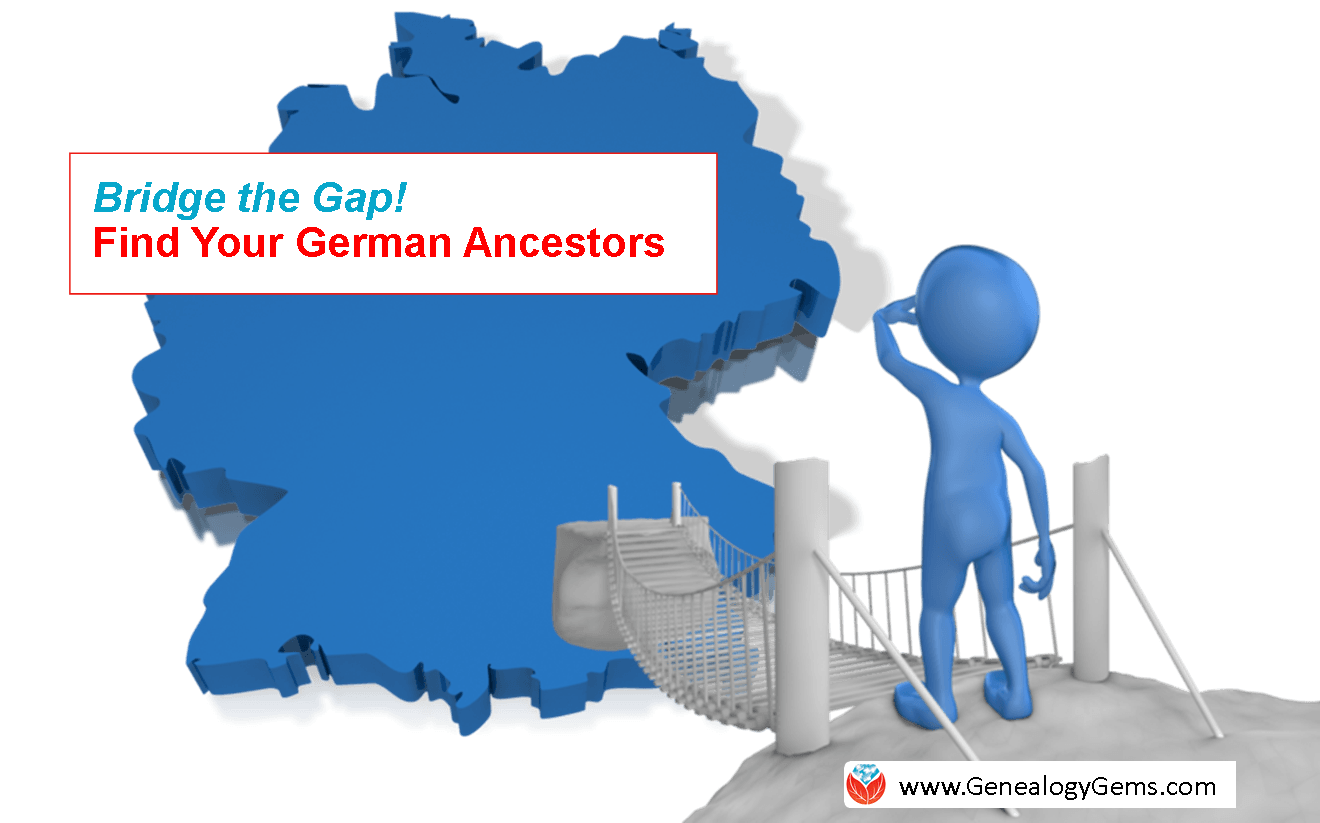
Recently I heard from Timo, a longtime Genealogy Gems fan and fellow genealogy podcaster whom I’ve met on the road before. He wrote to tell me about an exciting new international partnership to help those with German roots–wherever they live now–to reconnect with their German ancestors.
The partnership is called “Bridging the Gap between North America and Europe for Genealogists.” It’s a joint effort of the Germanic Genealogy Society, a German genealogy umbrella organization called Deutsche Arbeitsgemeinschaft genealogischer Verbände, and the Pommern Regional Group of Minnesota.
According to the partnership webpage, “This partnership forms a German-American genealogy structure between countries and organizations for sharing contacts and genealogical research. This partnership is open to all organizations interested in Germanic genealogical research.” Their plan is to develop contacts between members and organization and pool their collective knowledge of research strategies, resources, websites, guides, experts and speakers. They may eventually host conferences.
The partnership is between organizations, so to participate you’ll need to belong to one of the member societies. In addition to the founding partners listed above, several other societies have joined and others are in the process (see the partnership webpage, above). If you already belong to a society that has enough members with German roots, why not encourage your society to join the partnership?
Find German Ancestors with these Gems
German Newspapers in the U.S.: Read All About Them!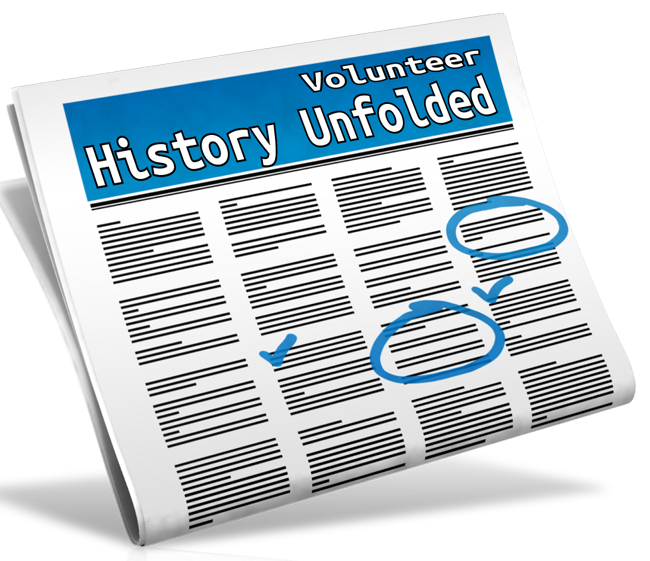
More German Genealogy Records at Ancestry.com
German Records Interview with Tamra Stansfield, AG (Genealogy Gems Premium website membership required)

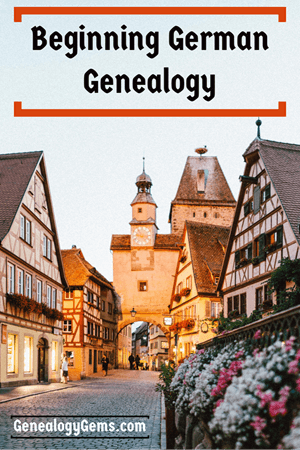
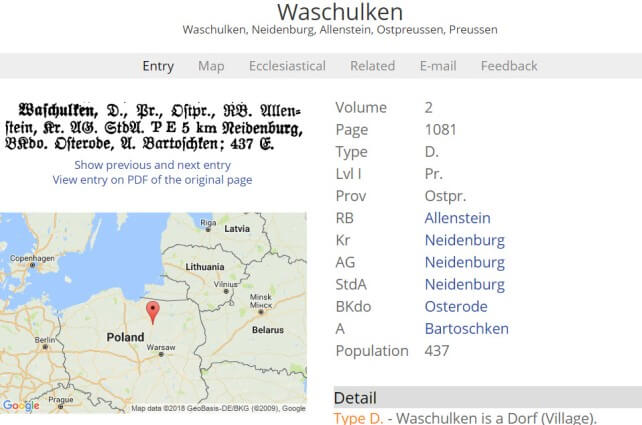















 German Newspapers in America is a virtual conference OnDemand video class by Jim Beidler. Stateside ethnic newspapers are a revealing resource for those searching their German ancestors. In this video you’ll learn:
German Newspapers in America is a virtual conference OnDemand video class by Jim Beidler. Stateside ethnic newspapers are a revealing resource for those searching their German ancestors. In this video you’ll learn:




